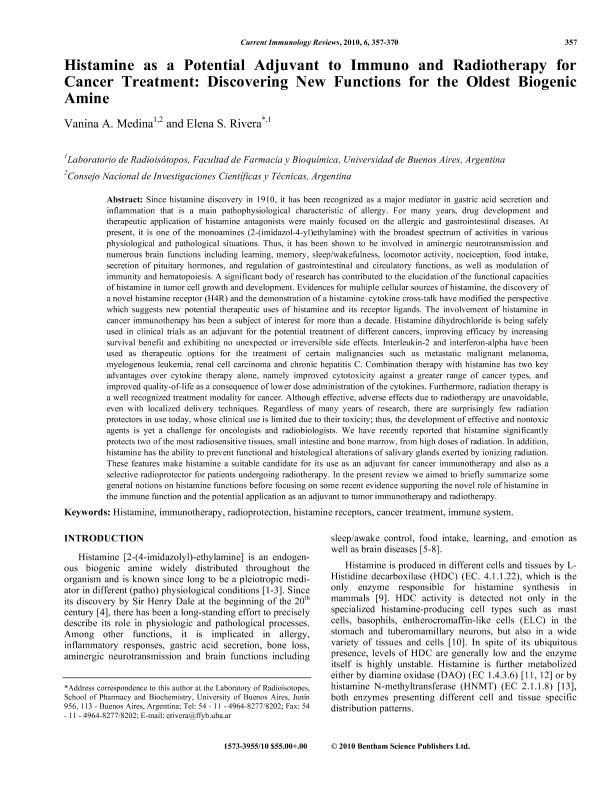Artículo
Histamine as a potential adjuvant to immuno and radiotherapy for cancer treatment: discovering new functions for the oldest biogenic amine
Fecha de publicación:
11/2010
Editorial:
Bentham Science Publishers
Revista:
Current Immunology Reviews
ISSN:
1573-3955
e-ISSN:
1875-631X
Idioma:
Inglés
Tipo de recurso:
Artículo publicado
Clasificación temática:
Resumen
Since histamine discovery in 1910, it has been recognized as a major mediator in gastric acid secretion and inflammation that is a main pathophysiological characteristic of allergy. For many years, drug development and therapeutic application of histamine antagonists were mainly focused on the allergic and gastrointestinal diseases. At present, it is one of the monoamines (2-(imidazol-4-yl)ethylamine) with the broadest spectrum of activities in various physiological and pathological situations. Thus, it has been shown to be involved in aminergic neurotransmission and numerous brain functions including learning, memory, sleep/wakefulness, locomotor activity, nociception, food intake, secretion of pituitary hormones, and regulation of gastrointestinal and circulatory functions, as well as modulation of immunity and hematopoiesis. A significant body of research has contributed to the elucidation of the functional capacities of histamine in tumor cell growth and development. Evidences for multiple cellular sources of histamine, the discovery of a novel histamine receptor (H4R) and the demonstration of a histamine – cytokine cross-talk have modified the perspective which suggests new potential therapeutic uses of histamine and its receptor ligands. The involvement of histamine in cancer immunotherapy has been a subject of interest for more than a decade. Histamine dihydrochloride is being safely used in clinical trials as an adjuvant for the potential treatment of different cancers, improving efficacy by increasing survival benefit and exhibiting no unexpected or irreversible side effects. Interleukin-2 and interferon-alpha have been used as therapeutic options for the treatment of certain malignancies such as metastatic malignant melanoma, myelogenous leukemia, renal cell carcinoma and chronic hepatitis C. Combination therapy with histamine has two key advantages over cytokine therapy alone, namely improved cytotoxicity against a greater range of cancer types, and improved quality-of-life as a consequence of lower dose administration of the cytokines. Furthermore, radiation therapy is a well recognized treatment modality for cancer. Although effective, adverse effects due to radiotherapy are unavoidable, even with localized delivery techniques. Regardless of many years of research, there are surprisingly few radiation protectors in use today, whose clinical use is limited due to their toxicity; thus, the development of effective and nontoxic agents is yet a challenge for oncologists and radiobiologists. We have recently reported that histamine significantly protects two of the most radiosensitive tissues, small intestine and bone marrow, from high doses of radiation. In addition, histamine has the ability to prevent functional and histological alterations of salivary glands exerted by ionizing radiation. These features make histamine a suitable candidate for its use as an adjuvant for cancer immunotherapy and also as a selective radioprotector for patients undergoing radiotherapy. In the present review we aimed to briefly summarize some general notions on histamine functions before focusing on some recent evidence supporting the novel role of histamine in the immune function and the potential application as an adjuvant to tumor immunotherapy and radiotherapy.
Archivos asociados
Licencia
Identificadores
Colecciones
Articulos(OCA HOUSSAY)
Articulos de OFICINA DE COORDINACION ADMINISTRATIVA HOUSSAY
Articulos de OFICINA DE COORDINACION ADMINISTRATIVA HOUSSAY
Citación
Medina, Vanina Araceli; Rivera, Elena S.; Histamine as a potential adjuvant to immuno and radiotherapy for cancer treatment: discovering new functions for the oldest biogenic amine; Bentham Science Publishers; Current Immunology Reviews; 6; 4; 11-2010; 357-370
Compartir
Altmétricas




